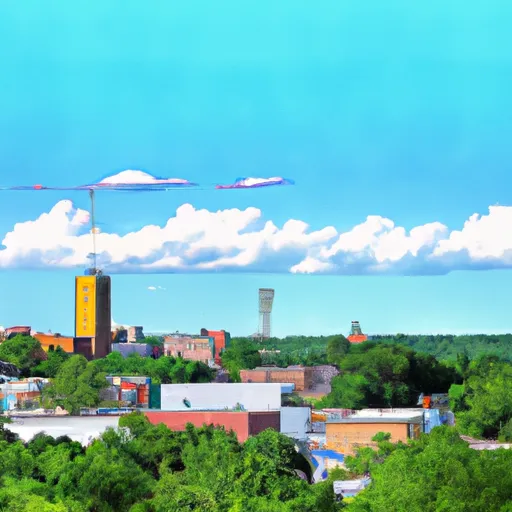-
 Snoflo Premium
Snoflo Premium
Get unlimited access to all our content
With no Ad interruptions! - Start Your Free Trial Login with existing account
Roscoe
Eden Index
Climate
6.2
•
Recreation
0.6
•
Community
•
Safeguard
2.7/10

Roscoe, Minnesota is a small town located in Stearns County, in the central part of the state. It experiences a continental climate, characterized by cold winters and warm summers. Average temperatures range from 10°F (-12°C) in winter to 80°F (27°C) in summer. The area receives around 30 inches of precipitation annually, with snowfall common during the winter months.
Roscoe is surrounded by beautiful lakes and rivers, making it a haven for outdoor enthusiasts. The hydrology constituents of the area include the Sauk River and nearby Lake Wobegon Trail. The Sauk River offers opportunities for fishing, canoeing, and kayaking, while the Lake Wobegon Trail provides a scenic route for biking, hiking, and horseback riding. Nature lovers can explore the surrounding parks and wildlife areas, such as Quarry Park and Nature Preserve, which offers hiking trails, swimming quarries, and picnic areas.
In conclusion, Roscoe, Minnesota offers a diverse climate with distinct seasons, making it an ideal destination for outdoor activities. The presence of the Sauk River, Lake Wobegon Trail, and nearby parks ensure a wide variety of recreational opportunities for residents and visitors alike.
What is the Eden Index?
The Snoflo Eden Index serves as a comprehensive rating system for regions, evaluating their desirability through a holistic assessment of climate health, outdoor recreation opportunities, and natural disaster risk, acknowledging the profound impact of these factors on livability and well-being.
Climate Health Indicator (CHI): 6.2
Roscoe receives approximately
737mm of rain per year,
with humidity levels near 84%
and air temperatures averaging around
7°C.
Roscoe has a plant hardyness factor of
4, meaning
plants and agriculture in this region thrive during a short period during spring and early summer. Most
plants will die off during the colder winter months.
By considering the ideal temperature range, reliable water supplies, clean air, and stable seasonal rain or snowpacks, the Climate Health Indicator (CHI) underscores the significance of a healthy climate as the foundation for quality living.
A healthy climate is paramount for ensuring a high quality of life and livability in a region, fostering both physical well-being and environmental harmony. This can be characterized by ideal temperatures, reliable access to water supplies, clean air, and consistent seasonal rain or snowpacks.
Weather Forecast
Streamflow Conditions
Upper Mississippi-Crow-Rum
Area Rivers
Upper Mississippi-Crow-Rum
Snowpack Depths
Upper Mississippi-Crow-Rum
Reservoir Storage Capacity
Upper Mississippi-Crow-Rum
Groundwater Levels
Recreational Opportunity Index (ROI): 0.6
The Recreational Opportunity Index (ROI) recognizes the value of outdoor recreational options, such as parks, hiking trails, camping sites, and fishing spots, while acknowledging that climate plays a pivotal role in ensuring the comfort and consistency of these experiences.
Access to outdoor recreational opportunities, encompassing activities such as parks, hiking, camping, and fishing, is crucial for overall well-being, and the climate plays a pivotal role in enabling and enhancing these experiences, ensuring that individuals can engage in nature-based activities comfortably and consistently.
Camping Areas
| Campground | Campsites | Reservations | Toilets | Showers | Elevation |
|---|---|---|---|---|---|
| Knutson Dam | 14 | 1,307 ft | |||
| Old Wadena County Park | None | 1,262 ft | |||
| Chippewa Loop | 46 | 1,369 ft | |||
| Bullard Bluff Campsite | None | 1,266 ft | |||
| Dower Lake Rec Area | None | 1,288 ft | |||
| Camp Cassaway | 10 | 1,306 ft | |||
| Knob Hill | None | 1,288 ft | |||
| Cass Lake | 23 | 1,335 ft | |||
| Stony Point | 44 | 1,336 ft | |||
| Truman City Park | None | 1,104 ft |
Nearby Fishing
Catastrophe Safeguard Index (CSI):
The Catastrophe Safeguard Index (CSI) recognizes that natural disaster risk, encompassing floods, fires, hurricanes, and tornadoes, can drastically affect safety and the overall appeal of an area.
The level of natural disaster risk in a region significantly affects safety and the overall livability, with climate change amplifying these risks by potentially increasing the frequency and intensity of events like floods, fires, hurricanes, and tornadoes, thereby posing substantial challenges to community resilience and well-being.
Community Resilience Indicator (CRI):
The Community Resilience Indicator (CRI) recognizes that education, healthcare, and socioeconomics are crucial to the well-being of a region. The CRI acknowledges the profound impact of these elements on residents' overall quality of life. By evaluating educational resources, healthcare accessibility, and economic inclusivity, the index captures the essential aspects that contribute to a thriving community, fostering resident satisfaction, equity, and social cohesion.

